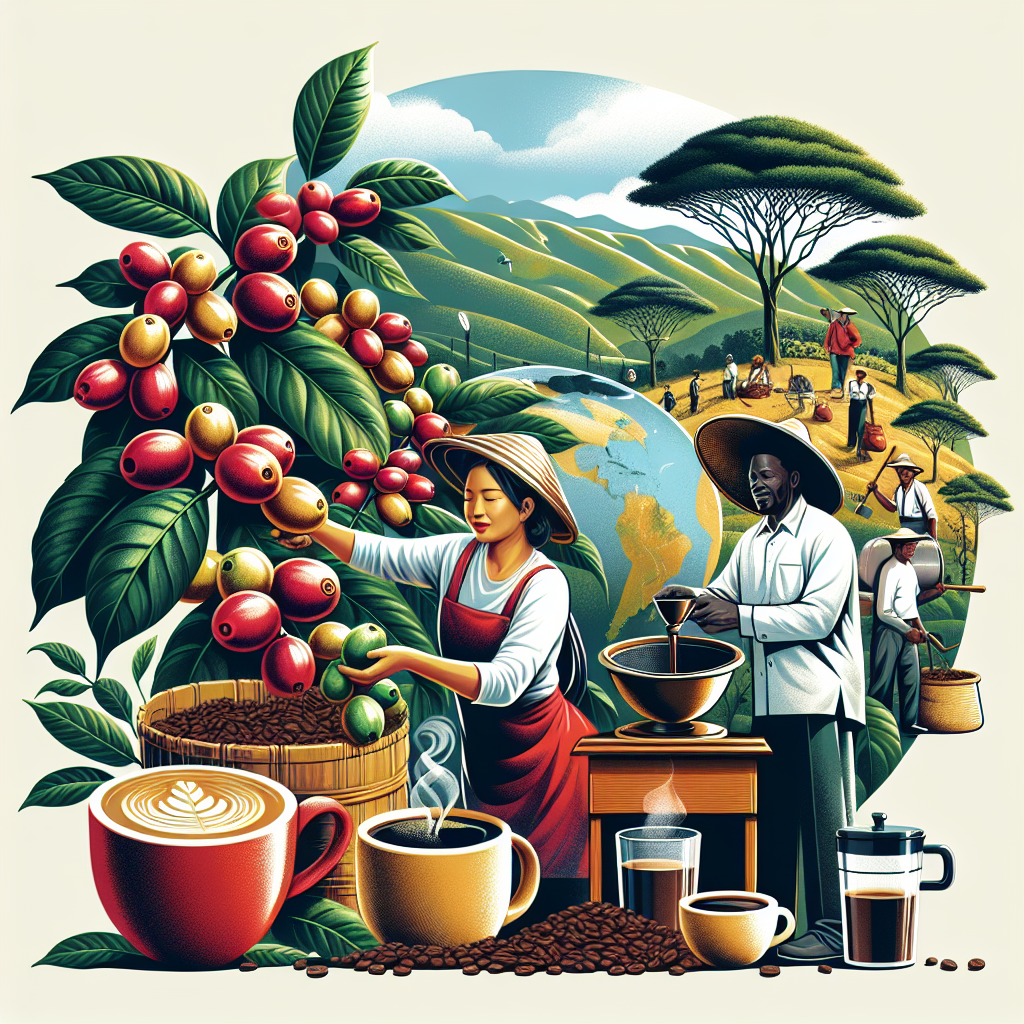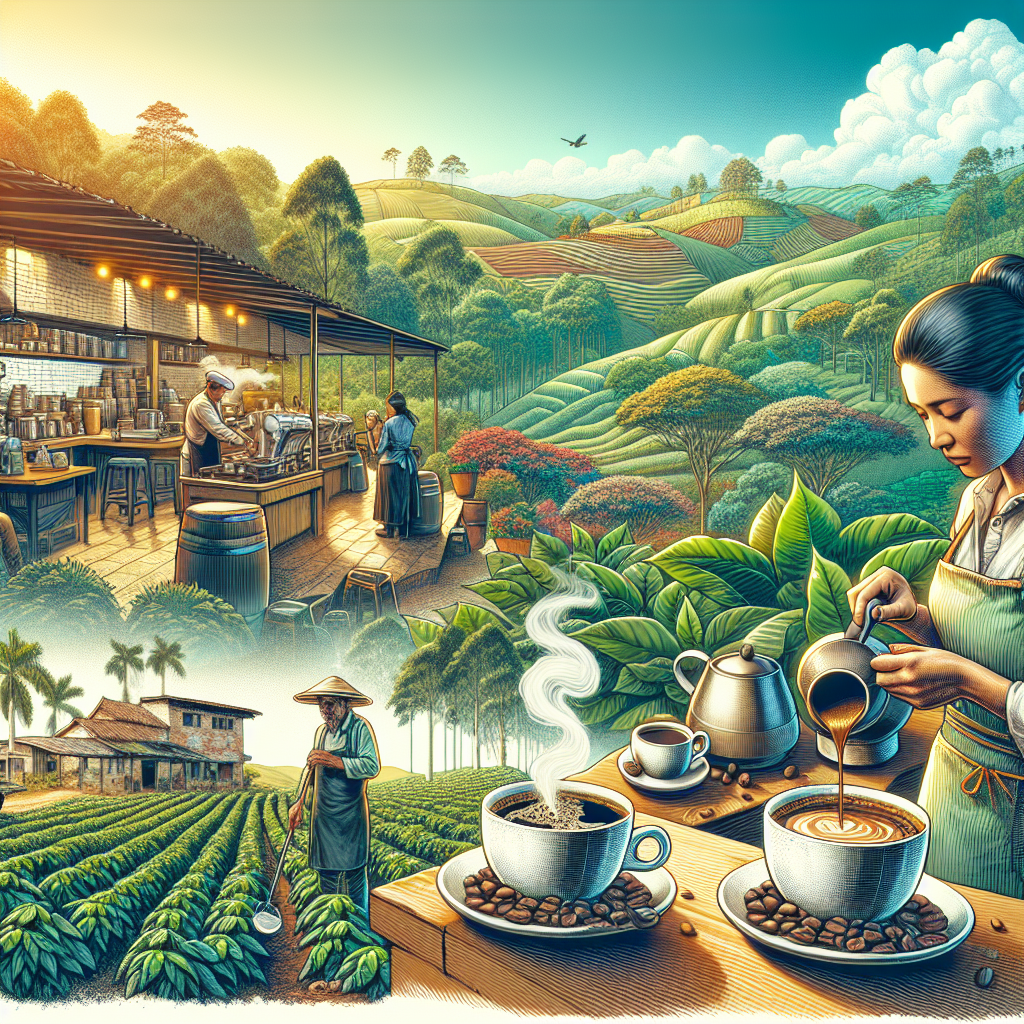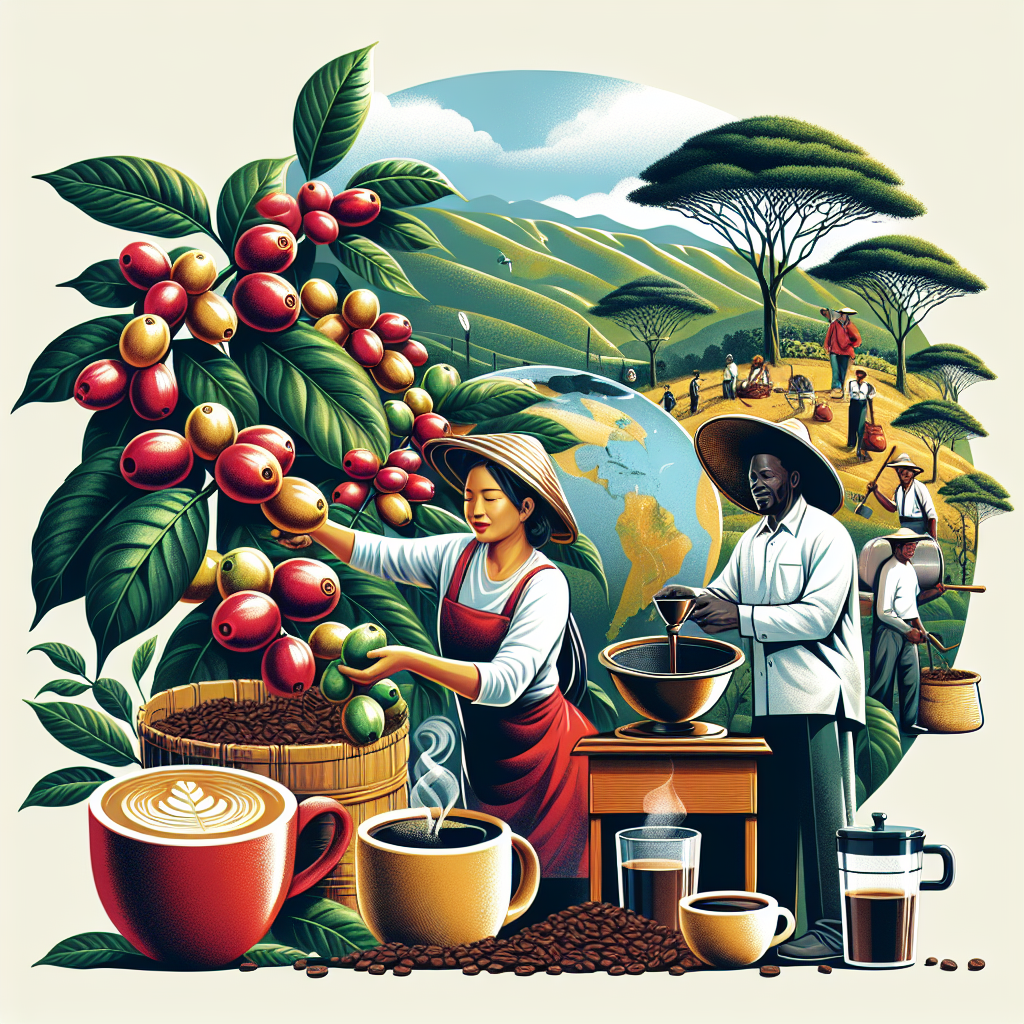Colombia, a country known for its lush landscapes and vibrant culture, is also celebrated for its rich coffee culture. In this captivating article, you will embark on a journey through the heart of Colombia, delving into the fascinating world of coffee production, learning about the long-standing traditions, and experiencing the warm hospitality of the locals. Join us as we explore the enchanting coffee farms nestled amidst picturesque valleys, savor the signature flavors of Colombian coffee, and uncover the stories behind this beloved beverage that has captivated the world. Embark on a sensory adventure and let Colombia awaken your love for coffee like never before.
History of Coffee in Colombia
Introduction to coffee in Colombia
Coffee has a long and rich history in Colombia, dating back to the early 18th century. The country’s unique geography and climate conditions make it the perfect place for coffee cultivation. Colombian coffee is known for its high quality and distinctive flavor profiles, making it one of the most sought-after coffees in the world.
Early cultivation of coffee in Colombia
Coffee cultivation in Colombia began in the early 18th century, when Jesuit priests brought coffee plants from the Caribbean island of Martinique. The first coffee farms were established in the region of Santander, and from there, the cultivation of coffee spread to other parts of the country. This early period of coffee cultivation laid the foundation for the industry to flourish in the years to come.
Boom of coffee production in the 19th century
The 19th century marked a significant boom in coffee production in Colombia. The introduction of steamships and the expansion of railroads made it easier to transport coffee from the interior regions of the country to the coastal ports. This led to an increase in exportation and the growth of the Colombian coffee industry. The demand for Colombian coffee grew rapidly, especially in Europe and the United States.
Coffee as a major economic driver in Colombia
Coffee quickly became a major economic driver in Colombia, contributing significantly to the country’s GDP. The revenue generated from coffee exports helped finance infrastructure projects, such as the construction of roads and railway systems. Coffee also played a crucial role in Colombia’s social and cultural fabric, shaping the country’s identity and traditions.
Geography and Climate Conditions
Ideal growing conditions for coffee in Colombia
Colombia’s diverse geography and climate conditions create the ideal environment for coffee cultivation. The country’s mountainous regions, particularly the Andes Mountains, provide the perfect altitude for coffee plants to thrive. The combination of tropical climate, rich volcanic soil, and consistent rainfall creates the optimal growing conditions for high-quality arabica coffee beans.
Different coffee regions in Colombia
Colombia is known for its distinct coffee regions, each with its own unique flavor characteristics. Some of the most famous coffee regions include Antioquia, Tolima, Huila, and Nariño. These regions have different microclimates and altitudes, resulting in variations in flavor profiles and acidity levels of the coffees grown there.
Distinctive characteristics of Colombian coffee
Colombian coffee is renowned for its well-balanced flavor profile, characterized by a medium body, bright acidity, and sweet notes. The coffee beans are often described as having hints of chocolate, caramel, and fruit flavors. This unique combination of flavors is a result of the country’s ideal growing conditions and the meticulous processing methods employed by Colombian coffee farmers.

Coffee Harvesting and Processing
Manual picking of coffee cherries
In Colombia, coffee cherries are typically harvested by hand to ensure the selection of only ripe cherries. This meticulous process involves skilled laborers carefully picking the cherries, ensuring that only the fully matured ones are harvested. Manual picking allows for better quality control and helps maintain the high standards of Colombian coffee production.
Processing methods: Washed, semi-washed, and natural
After harvesting, the coffee cherries undergo a series of processing methods to remove the outer fruit and extract the coffee beans. The three main processing methods used in Colombia are washed, semi-washed (also known as honey process), and natural. The washed process involves fermenting the coffee beans to remove the outer skin, while the semi-washed process leaves some of the fruit pulp on the beans. The natural process involves drying the cherries with the fruit intact, resulting in a unique flavor profile.
Role of fermentation in coffee processing
Fermentation plays a crucial role in the coffee processing methods used in Colombia. During fermentation, enzymes break down the sugars in the coffee cherries, resulting in the development of complex flavors. This process can be controlled to a certain extent, allowing coffee producers to create distinct flavor profiles in their coffees. The duration and conditions of fermentation are carefully monitored to ensure consistency and quality in the final product.
Traditional Coffee Farms in Colombia
Small-scale family-owned coffee farms
Colombian coffee farming is largely dominated by small-scale family-owned farms. These farms have been passed down through generations, with each family member playing a crucial role in the cultivation and processing of coffee. The close-knit nature of these farms allows for careful attention to detail and the preservation of traditional farming practices.
Traditions and rituals in Colombian coffee farming
Colombian coffee farming is not just a job, but a way of life deeply rooted in traditions and rituals. Coffee farmers take pride in their craft and follow age-old practices passed down from their ancestors. These traditions include planting coffee trees during specific moon phases, using specific pruning techniques, and celebrating harvest seasons with community festivities. These traditions are not only a means of preserving cultural heritage but also contribute to the unique flavor profiles of Colombian coffee.
Sustainable practices in coffee cultivation
Colombian coffee farmers prioritize sustainability in their farming practices. Many farms employ organic and shade-grown methods to preserve the natural ecosystem and reduce the use of chemical inputs. Additionally, some coffee farms have implemented fair trade and direct trade initiatives, ensuring that farmers are paid fair wages for their labor. These sustainable practices not only benefit the environment but also contribute to the long-term viability of the Colombian coffee industry.

The Coffee Tasting Experience
Introduction to coffee cupping
Coffee cupping is a method used to evaluate the aroma, flavor, and overall quality of coffee. It is a sensory experience that allows coffee enthusiasts, industry professionals, and buyers to assess the characteristics and nuances of different coffees. Colombian coffee cupping sessions are highly valued and give participants the opportunity to appreciate the complexity and diversity of flavors found in Colombian coffee.
Steps of a coffee tasting
A coffee tasting, or cupping, typically involves several steps to fully analyze and appreciate the coffee’s attributes. First, participants evaluate the aroma of the freshly ground coffee. Next, they pour hot water onto the coffee grounds and observe the development of a crust. After breaking the crust, they carefully slurp the coffee, allowing the flavors to spread across their palate. Finally, participants rate the coffee based on its acidity, body, flavor, and aftertaste.
Identifying flavor profiles in Colombian coffee
Colombian coffee offers a wide range of flavor profiles that can be identified during cupping sessions. These flavor profiles include but are not limited to notes of chocolate, caramel, berries, citrus, nuts, and floral undertones. Through the coffee tasting experience, participants can explore the intricacies of Colombian coffee and gain a deeper understanding and appreciation for its unique qualities.
Colombian Coffee Varieties
Arabica vs. Robusta coffee beans
Colombia primarily cultivates arabica coffee beans, which are known for their superior quality and delicate aroma. Arabica beans have a lower caffeine content and a more refined flavor profile compared to robusta beans. The high altitude and ideal climate conditions in Colombia contribute to the production of flavorful arabica coffee.
Common coffee varieties grown in Colombia
Colombian coffee farms cultivate various coffee varieties, each with its own distinct characteristics. Some common coffee varieties grown in Colombia include Caturra, Typica, Bourbon, and Castillo. These varieties differ in terms of flavor, acidity, yield, and resistance to diseases. The selection of the coffee variety depends on factors such as regional climate, elevation, and the specific preferences of the coffee farmer.
Specialty coffee varieties in Colombia
Colombia is known for its specialty coffee varieties, which are highly sought after by coffee connoisseurs around the world. Specialty coffees are produced using specific methods and come from single-origin farms. Some of the specialty coffee varieties found in Colombia include Geisha, Pink Bourbon, and Tabi. These varieties often exhibit exceptional flavors and are grown in limited quantities, making them highly prized in the coffee industry.
Coffee Farm Tours and Experiences
Popular coffee farm destinations in Colombia
Coffee farm tours have become increasingly popular in Colombia, offering visitors the chance to immerse themselves in the world of coffee production. Some popular coffee farm destinations in Colombia include the Coffee Cultural Landscape, which is a UNESCO World Heritage site, as well as regions like Quindio, Caldas, and Risaralda. These destinations provide visitors with breathtaking landscapes, rich cultural experiences, and the opportunity to learn about the coffee production process firsthand.
Guided tours and activities on coffee farms
Coffee farm tours typically include guided tours of the farms, where visitors can witness the various stages of coffee production. They can participate in picking coffee cherries, learn about the processing methods, and even try their hand at roasting coffee beans. Additionally, visitors can enjoy cupping sessions, coffee tastings, and indulge in traditional Colombian cuisine made from locally sourced ingredients.
Hands-on coffee production workshops
For those seeking a more immersive experience, many coffee farms offer hands-on workshops where participants can learn the intricacies of coffee production. These workshops cover topics such as picking and sorting coffee cherries, processing methods, roasting techniques, and brewing methods. Participants get to work alongside experienced coffee farmers, gaining valuable insights into the art and science of coffee production.
Role of Coffee in Colombian Society
Coffee as a symbol of Colombian identity
Coffee holds a significant place in Colombian society and is often considered a symbol of national identity. It represents the hard work, dedication, and craftsmanship of Colombian coffee farmers. Coffee is deeply ingrained in the cultural fabric of the country, and its presence can be felt in daily life, social gatherings, and celebrations.
Coffee in social gatherings and celebrations
Colombians have a strong coffee culture and often use coffee as a way to connect with others. Coffee is commonly served in social gatherings, whether it’s a casual get-together or a formal event. It is a gesture of hospitality and a way to bring people together. Additionally, coffee is an integral part of celebrations, such as weddings, holidays, and festivals, where it is enjoyed in abundance.
The role of coffee in the economy and employment
Coffee plays a vital role in the Colombian economy, contributing significantly to employment and income generation. The coffee industry provides jobs for thousands of Colombians, from coffee farmers and pickers to exporters and coffee shop owners. The revenue generated from coffee exports helps support local communities and stimulates economic growth in the country.
Coffee Culture in Colombian Cities
Coffee in daily life: cafes, street vendors, and offices
Coffee is deeply embedded in the daily life of Colombians, especially in urban areas. Cafes and coffee shops can be found on almost every street corner, serving as gathering places for friends, colleagues, and families. Street vendors also play a significant role in the coffee culture, offering fresh, brewed coffee to locals on the go. Additionally, coffee is a staple in offices and workplaces, providing a much-needed energy boost throughout the day.
Famous coffee shops and coffee chains in Colombia
Colombia is home to several famous coffee shops and coffee chains that have gained international recognition. Juan Valdez Café, named after a fictional coffee farmer character, is one of the most iconic coffee brands in Colombia. This brand has achieved global success, with its coffee shops serving as ambassadors of the Colombian coffee culture. Other popular coffee chains in Colombia include Oma, Tostao, and Amor Perfecto, which offer a wide variety of specialty coffees.
Coffee-themed events and festivals
Colombia hosts numerous coffee-themed events and festivals throughout the year, celebrating the country’s rich coffee culture. The National Coffee Festival in Manizales is one of the most well-known events, attracting coffee enthusiasts from all over the world. This festival showcases coffee competitions, cultural performances, art exhibitions, and traditional coffee brewing methods. These events provide a platform for coffee lovers to come together, learn, and appreciate the beauty of Colombian coffee.
Colombian Coffee Industry Challenges
Coffee rust disease and other pests
One of the major challenges faced by the Colombian coffee industry is coffee rust disease, also known as “la roya.” This fungal disease attacks coffee plants, causing defoliation and reducing crop yields. Colombian coffee farmers have implemented various strategies to combat this disease, including the use of resistant coffee varieties, regular monitoring, and strict sanitation practices. Additionally, pests such as coffee berry borer and nematodes also pose a threat to coffee production in Colombia.
Market fluctuations and price volatility
The global coffee market is subject to frequent fluctuations and price volatility, which can impact coffee farmers’ livelihoods. Colombian coffee farmers often face challenges with the unpredictable nature of coffee prices, as they rely heavily on income from coffee exports. To mitigate these risks, some farmers have adopted diversification strategies by growing alternative crops or venturing into specialty coffee markets. Additionally, fair trade initiatives have been instrumental in providing stable prices and ensuring a fairer income for coffee farmers.
Sustainability and fair trade initiatives
Colombia faces the ongoing challenge of balancing coffee production with sustainable practices and fair trade principles. Climate change and deforestation pose threats to the coffee industry, while fair trade initiatives seek to improve the livelihoods of coffee farmers and promote environmentally friendly practices. The Colombian government and organizations are working together to implement sustainable agriculture programs, improve infrastructure, and provide training and support to farmers. These initiatives aim to ensure the long-term viability of the Colombian coffee industry while protecting the environment and promoting social equity.
In conclusion, the history of coffee in Colombia is deeply intertwined with the country’s culture, economy, and identity. The unique geography and climate conditions of Colombia have made it an ideal location for coffee cultivation, resulting in high-quality and distinctive coffees. Through traditional farming practices, sustainable cultivation methods, and a strong coffee culture, Colombia has established itself as a leading producer of specialty coffees. However, the Colombian coffee industry also faces challenges such as diseases, market fluctuations, and sustainability concerns. Despite these challenges, the passion and dedication of Colombian coffee farmers continue to shape and enrich the world of coffee.

